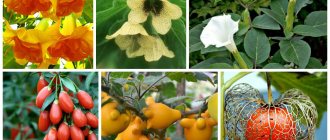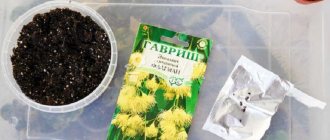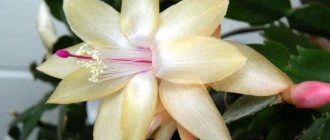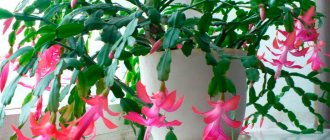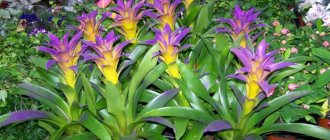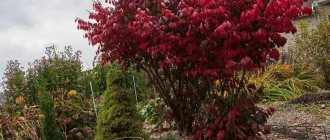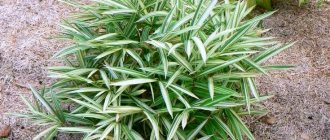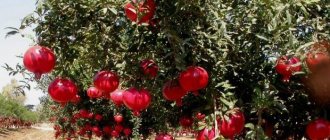Types of euonymus with photos and names
The Latin name of the euonymus - Evonymus - combines 2 Greek words - “good” and “name”, as a result, literally, it is a flower “with a good name”. Slavic tribes began to call the shrub the euonymus, to whom the plant was also known as bruslina, brusklet, kizlyanka, night blindness, witch's earrings, wolf's bast, privet.
Now these names are practically not used. In southern Russia, the shrub is still called pseudolaurel.
There are about 220 species in the genus Celastraceae, of which about 130 are evergreen. A mature tree reaches more than 4 m in height. The plant's homeland is considered to be the temperate climatic zones of Asia, China, and the Himalayas; the flower is widely distributed in Australia, Europe, and South America. Up to 20 species can be found in the forests of Russia and Ukraine.
Most often grown at home:
- rooting euonymus (radicans) or Fortune (Euonymus fortunei), which does not exceed 50-60 cm in height. The plant has small ovoid varnished leaves and a dense crown with aerial roots at the nodes of the branches;
- Japanese euonymus (Euonymus japonica) is a shrub with serrated elliptical leaves with yellow, golden or white spots, not exceeding 8 cm in length. Euonymus has few flowers, they are small, pale yellow, collected in axillary inflorescences. After flowering (in June-July), leathery boxes of an orange-pink hue are formed in their place.
Such types of shrubs as European euonymus, dwarf euonymus (compactus) and winged euonymus (alatus) are less common in everyday life. They are often grown under the “mix” brand.
It is believed that it is difficult to make euonymus bloom indoors, so it is not cultivated as a flowering shrub, but is grown mainly for its beautifully colored foliage.
Varieties grown at home
Of the “natural” euonymuses, the ones that have most successfully adapted to home conditions are:
- Japanese (japonica). A small, intensively branching shrub, no more than 0.5–0.7 m high, densely covered with leaves. They are narrower than those of most euonymuses, shaped like a lancet or an elongated oval. The color of the leaf blade is rich green, sometimes with a lighter border or area along the central vein. The flowers are small, no more than 1 cm in diameter. The fruits are pinkish or pale orange boxes. It is demanding on soil nutrition and requires regular fertilizing. Moderate watering is important. The tree is sensitive to sudden changes in temperature and has difficulty escaping pest attacks. In extreme heat it drops its leaves.
- Rooting (radicans) or Fortune (fortunei). A low (1–1.2 m) creeping evergreen plant with long shoots. It branches rather weakly, but the existing shoots are tightly covered with leaves. They are small (4–5 cm long), smooth and shiny. The general background is yellow or yellow-white, with a green tint. At home you can grow them in hanging pots. The fruits are bright pink, the seeds are dark orange.
- Dwarf (compactus). Height - no more than 1 m. Leaves are small, up to 4 cm long, leathery. The tip of the leaf sharply sharpens, the edges bend slightly downwards. The color of the leaf blade is light green, with a slight yellowish tint. The leaves below are bluish-green or olive. The trunk is practically absent, the shoots are thin. Suitable for bonsai shaping. Unlike other varieties, it is more shade-loving and demanding of watering, and more often suffers from pests. Does not tolerate heat well.
- Winged (alatus). Deciduous shrub approximately 1.5–2 m high. It grows quite slowly. The ribs on the shoots look like wings, hence the name. The dark green leaves turn into bright scarlet and crimson in the fall. The fruits are deep purple. The plant is light-loving. It will survive in the shade, but will lose color saturation.
Interesting Facts
Some plant species are gutta-perchenos. Gutta is found in all parts of the tree, especially in the bark.
Flower growers value euonymus for its ability to heal and disinfect indoor air.
Carefully! Euonymus is a poisonous plant; substances contained in the leaves and stems negatively affect the functioning of the cardiovascular system. Therefore, when caring for it, you need to use protective gloves. Do not allow pets to come into contact with the flower.
Use in landscape design
Euonymus is successfully used in landscape design. From varieties intended for cultivation in open ground, miniature hedges and lawns are formed . Large spreading specimens look good in group plantings and flower beds.
As for indoor plants, in the warm season they can also be placed in the garden. They will become a real decoration of the terrace, creating decor on the territory of a rock garden or alpine slide . They will look harmonious next to low-growing coniferous plants, adding some variety to the green background with their variegated foliage.
Pots with euonymus can be installed as a border of a flower bed, or used to decorate garden paths. The mobility of such plants has a great advantage in that it makes it possible to periodically change the landscape picture throughout the summer . In autumn, plants must be brought indoors.
What does euonymus look like?
Euonymus is a shrub or tree no more than 1-1.5 m high. The shoots are long and can be erect, climbing or drooping. The stems are tetrahedral, with opposite leaves of monochromatic or variegated (up to 5-6 shades) color, which can vary depending on the time of year. The crown is thick and lush. Euonymus flowers are small, inconspicuous, and are of no decorative interest.
In addition to the variegated foliage, the exotic appearance of the plant is given by the leathery boxes that form in place of the flowers.
General information
Euonymus is famous for its decorativeness. The greatest aesthetic value is provided by greenery, which can be painted in different colors and have an interesting natural pattern. Usually these are lush, bright bushes, but creeping and creeping varieties are also found.
In captivity, the plant usually does not bloom, and therefore does not bear fruit. Euonymus has many names among people. Most often they are associated with its toxicity. The juice and seeds of the plant are dangerous.
Plant care
Indoor euonymus is unpretentious, but you need to know a few tricks to make growing more effective.
Selecting a location
Experienced gardeners recommend choosing sunny, spacious rooms to keep the plant. It is better to keep the euonymus on the southeast and southwest window. It is believed that the tree tolerates partial shade and even shade well, but in order to maintain the diversity of leaves, constant sunlight is necessary at any time of the year.
It is good if it is possible to periodically ventilate the room without creating drafts. At the same time, euonymus loves high humidity in the room.
Temperature
To make the plant feel comfortable, it is better to keep it at a temperature no higher than 25° C in the warm season and no lower than 10-15° C in autumn and winter. During the cold period, you can create a tree in a cooler climate if it suddenly begins to lose leaves.
In summer, it is best to take the flower pot out into the open air and place it in bright sun. It is necessary to put it in the shade only when the ambient temperature rises above 27° C, otherwise the leaves will quickly dry out and fall off.
Watering
In the summer, the flower needs abundant watering - this is the main condition. But water should not be allowed to stagnate at the roots for a long time - this contributes to their rotting. Dry soil in a pot can cause leaves to fall off quickly.
In winter and autumn, the moisture supply should be halved; it is enough to lightly moisten the top layer of soil.
For irrigation, it is necessary to use only settled water at room temperature, because... cold, hard water from the tap can burn the roots and cause the plant to begin to lose its leaves. Periodic spraying and weekly warm showers are of great benefit.
Top dressing
If the flower is initially planted in fertile soil, then it does not need constant feeding. It is enough to water it once a month in spring and summer with complex mineral fertilizer. You can use manure infusion in a ratio of 1:10.
Crown formation
Pruning is carried out annually to form the crown and rejuvenate the plant during the growing season, while dry, weak, elongated shoots are removed.
Optimal microclimate for the plant
Euonymus is relatively unpretentious. It will survive in different conditions. But in order for the plant to look its best, it is advisable to listen to its “requirements” and create a microclimate close to the optimal one.
Table: how to create suitable conditions for euonymus
| Factor | Recommendations |
| Location | The sill of a window facing southeast or southwest. The room must be regularly ventilated, while protecting the plant from drafts. In the summer, it is useful to send the pot to the balcony (indoor or outdoor), terrace, veranda, or garden. |
| Lighting | Most types of euonymus prefer bright light, without even suffering from direct sunlight. Variegated hybrids are more light-loving, but under direct rays they quickly “fade”, so it is advisable to shade them. |
| Temperature | The optimal temperature in summer is 22–25ºС, in winter 12–15ºС. In winter, hybrids will tolerate lower (3–5ºС), but not negative temperatures. “Natural” euonymus is not afraid of frosts down to -20ºС. If the room is too warm in winter (20ºC or more), even an evergreen euonymus will most likely lose most of its leaves. |
| Air humidity | Euonymus grows best in high humidity (60–70%), but does not suffer much from dry air. In extreme heat, you can spray the flower or periodically give it a warm shower. The last procedure is also useful for cleaning the flower from dust (once a week is enough). |
Euonymuses are mostly shade-tolerant, but not shade-loving. A compact, even crown of the bush is formed only in bright light or at least in light partial shade.
Euonymus will tolerate both shade and completely artificial light, but will not form a beautiful crown in such conditions.
Reproduction
It occurs in 2 ways: seed and vegetative.
Using the seeds that form in the boxes of faded euonymus, you can grow several specimens at the same time. Growing shrubs in this way has a big disadvantage - seedlings take a very long time to appear, so at home it is better to propagate the flower using cuttings.
Seeds
The soil for euonymus should be loose, slightly alkaline, well permeable to air, and rich in nutrients. A mixture of equal parts of turf soil, sand and humus is recommended. It is useful to add a small amount of loam to the substrate.
You can use soil for decorative foliage plants, which is sold in specialized stores.
For germination, you will need an airtight container into which moistened sand is poured and the seeds are placed. The tightly closed tray is placed in the refrigerator for 3 months for stratification.
After the expiration date, the container is taken out, opened, covered with glass and exposed to bright light to warm up.
The prepared soil is sterilized in the oven and heated planting material is laid out on it. Sprinkle with substrate and irrigate with a spray bottle. Cover with glass or film and expose to the sun until germination, which can last 3-8 weeks. As soon as 1 leaf appears on the shoots, they are picked into pots and placed in a permanent place. It is better to plant shallowly to allow the root system to develop.
Cuttings
To carry out cuttings, you will need an adult plant and a sharp knife. A cutting (5-7 cm long) is cut from the mother flower, preferably from the top. It is recommended to do this in August-September. For the seedling you need to build a mini-greenhouse. The shoot is buried in a mixture of sand and peat until roots sprout. As soon as it begins to grow, they dive into a permanent container.
Important! The pot for euonymus should be small to limit the growth of the root system. At the bottom it is necessary to arrange drainage from expanded clay or finely chopped red brick to prevent rotting of the roots due to stagnation of water. Euonymus can be propagated by cuttings in early spring.
Trimming and shaping
Pruning, as a rule, is purely aesthetic in nature, but it has a good effect on the shrub: it grows more actively, the crown becomes more luxuriant. Pruning is carried out in early spring.
You just need to pluck or cut off (with a sharp, disinfected instrument, so as not to introduce any infection into the plant’s body) the leaves that are knocked out of the crown and give the bush an unkempt appearance. Also, during pruning, it is easy to form an euonymus on a trunk, that is, as if on a trunk.
Transfer
This plant needs to be replanted once every 2-3 years. In this case, the pot is taken not much larger than the previous one. The best soil is a mixture of turf, humus and leaf soil in a ratio of 2:1:1. To deoxidize the soil, you can add crushed chalk (5 g per 10 kg).
To make the transplant less painful, the roots are not completely cleared of soil, but the entire lump is transferred into a new container and, adding fresh substrate to the side and on top, lightly compact it. Spray, water the flower and place it in its usual place.
Description of indoor euonymus
The indoor euonymus was first described by Carl Linnaeus. It was he who gave it the scientific name eonimus, which translated means “glorious plant.”
Euonymus is an evergreen tree plant that is part of the Euonymus family. It is found in various parts of the planet Earth in areas with subtropical and temperate climates.
This genus includes low-growing shrubs and trees, which can be either evergreen or deciduous. The ribbed shoots are tetrahedral. The opposite leaf blades, leathery to the touch, have a glossy surface. The foliage can be either green or variegated. During flowering, unattractive flowers are formed that do not add decorative value to the plant. During pollination, a dry box is formed in place of the flower, inside which the seeds are located.
Difficulties in growing
A plant, especially an adult, may periodically experience problems.
| Problem | Cause | How to fight | Prevention |
| Leaves fade, curl, edges dry out | Too much sun rays | Shade | Choose the optimal location |
| Leaves fade, curl, edges dry out | Overmoistening | Let the earthen coma dry | Optimize the watering regime |
| Leaves fall, root system dies | Overmoistening | Dry the earthen lump | Optimize watering |
Is it possible to keep Euonymus at home: signs and superstitions
Euonymus not so long ago became known as a houseplant and spread around the world (previously it was popular only in Asian countries - China, Japan, Korea - as an element of landscape design), so it has not yet acquired signs and superstitions, after all, for this it takes a certain amount of time. In Asian countries, euonymus was most often grown outside, outside the home, and there were no special rules associated specifically with euonymus: general rules for arranging plants according to Feng Shui were used, not related to a specific genus of plants.
But it is known that from Latin the name “euonymus” is translated as “glorious, good.” It is also sometimes called pseudo-laurel, and laurel is associated with the victories and successes of Roman commanders, who were crowned with a laurel wreath for great achievements. Therefore, it can be assumed that the euonymus has warm energy, it attracts good luck into the house and protects its owners from troubles. Or, at least, it just pleases with bright greenery.
There are several legends about how the euonymus appeared.
According to the first, it appeared thanks to the ancient Greek goddess of plants, Flora. One day she was walking through the forest, and suddenly she lost her earring and pendant. The goddess became angry at the wayward decorations and ordered them to become poisonous plants. This is how the euonymus appeared: its leaves are shaped like the pendant of a beautiful goddess, and the berries resemble her earring.
According to another legend, the euonymus was created by an evil witch as a punishment for people who had deeply offended her in some way. Later, the witch repented of her evil deed and ordered the euonymus to be not only poisonous, but also a medicinal plant (sometimes decoctions of euonymus leaves are used as a folk medicine against migraines, but this is a dangerous undertaking!). However, the witch was so exhausted by these transformations that she herself turned into a gray bird and began to flutter around the euonymus, feeding on its fruits.
According to the third legend, the euonymus and that same gray bird are lovers who were separated during life, but united after death.
Diseases and pests
Like other plants, euonymus is affected by diseases and parasites. Many novice gardeners often have questions about why the leaves turn black or fall off.
| Pests | Manifestation | Struggle |
| Shchitovka | Falling and curling of leaves | Apply Actellik solution (0.15%), reduce air humidity. |
| Spider mite | Small mites and a thin thick web between the leaves | Clean the leaves from mites, treat with garlic infusion, spray periodically |
| Gray rot | Velvety gray or brown coating on leaves | Occurs due to excessive soil moisture, so reduce watering |
To protect themselves from possible difficulties, it is better for novice flower growers to purchase their 1 euonymus in a specialized store and learn how to properly care for it.
How does a flower react to the grower's mistakes?
The main decorative value of euonymus is its leaves. They are a reliable “indicator” of the plant’s condition. The plant reacts to any errors in care by deteriorating its appearance.
Table: how errors in caring for euonymus manifest themselves
| What does the plant look like? | What is the reason? |
| The leaves become dull, the variegated color disappears, and the tips dry out. | The room is too dry or there is insufficient watering. Another possible reason is prolonged exposure to direct sunlight. |
| The plant sheds its leaves. | If this occurs during the active growing season, is associated with an almost complete stop of growth and affects only the lower leaves, the flower is watered too often and/or abundantly. In winter, too high temperatures and low air humidity are to blame. |
| Brown spots spread on the leaves, the bases of the petioles and shoots turn black. | Rot develops due to regular waterlogging of the soil, and the situation is aggravated by low indoor temperatures. |
| The leaves turn yellow, gradually dry out and fall off. | The plant lacks nutrients. Or the fertilizer used is not suitable for it. |

